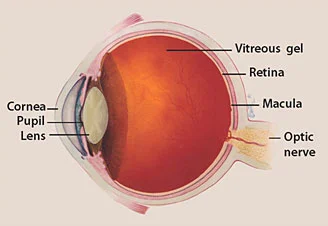Age-Related Macular Degeneration
/Macular degeneration is deterioration in the central area of the retina, called the macula. The macula is a part of the eye within the retina which is responsible for giving us sharp, central vision. Because of the central location of the macula, the effects of macular degeneration can be debilitating to those who suffer from it. Moreover, macular degeneration is the leading cause of vision loss for those over 50, effecting over 10 million Americans.
Age-related macular degeneration can be categorized into two types, wet and dry, which we will go over more in depth later on. In both types, central vision – needed for reading, driving and recognizing specific colors and faces – is blurred.
What are the symptoms of macular degeneration?
Macular degeneration usually develops gradually and as such can seem like normal age-related vision change or deterioration. For a smaller group of people the disease progresses rapidly, and can lead to vision loss in one or both eyes in a short period of time. The main symptoms people experience include:
· Straight lines or faces appearing wavy
· Doorways seeming crooked
· Objects appearing smaller or farther away
· Increasing difficulty adapting to low light levels
· Decreasing color intensity or brightness
· Difficulty recognizing faces
· Increasing vision haziness
· Blurry or blind spots in central vision
What causes macular degeneration?
As mentioned, there are two types of macular degeneration. Wet and dry. Each of these is caused by something different. Dry macular degeneration is the most common form and is caused by the gradual deterioration of light-sensitive cells in the macula. Drusen, yellow deposits behind the retina, eventually dislodge the macula from its normal place. The size and number of these spots can be an indication for the severity of the disease.
The rarer, more serious form of the disease, is wet macular degeneration. This is only present in about 15% of cases, and occurs when abnormal blood vessels grow underneath the retina. These blood vessels leak blood and fluid and cause swelling to the area, eventually damaging the macula. This form is more serious because it can cause trigger vision loss.
Beyond these specific causes, there are other risk factors that come into play and increase the chances of being affected by the illness. The risk certainly increases with age, but some of the following do as well:
· Family history
· Smoking
· Obesity
· High blood pressure
· High cholesterol
· Being Caucasian
· Being female
· Diet low in fruits and vegetables
How is macular degeneration diagnosed?
Any changes in the center of the field of vision should prompt you to get evaluated by a physician. This is especially true for people over 60 who are more likely to be affected. Here are some tests that can be run to help make a diagnosis:
· Visual acuity test
· Dilated eye exam
· Amsler grid
· Angiogram
· Tomography
Hoe is macular degeneration treated?
Currently there is no cure for macular degeneration, but there are three treatments that can help those with the wet form of the disease. These are:
1. Laser surgery: to destroy leaky blood vessels behind the retina
2. Growth factor blocking injections into the eye: to block the stimulation of abnormal blood vessel development
3. Photodynamic therapy: injection of a light-activated drug into the bloodstream in combination to a light being shone into the eye to destroy new blood vessel growth
Some studies have shown that a combination of high-dose antioxidant vitamins and zinc can be taken to slow down the progression of dry macular degeneration. The vitamins given include, vitamin C, vitamin E, beta carotene, zinc, and copper.

